
  |
Olive Ash - United Kingdom
A medium to large tree, reaches a
height of 25-30m, a diameter of 0.6-1.5m. Heartwood is cream to olive
brown, larger logs usually have an olive heart which is usually irregular
and streaked. Sapwood in smaller logs is not usually distinguishable from
the heartwood. Straight to wavy grain, coarse texture. Dries rapidly with
only slight end checking. Machines and turns well, takes an excellent
polish. Used for sports equipment (such as racquets), cabinet making,
joinery, furniture and is often veneered, an easy wood to turn. |

  |
Spalted Beech - United Kingdom
The heartwood is a very pale
pink brown. It has a fine, close grain with an even texture. Easy to work
and dries fairly quickly but with a tendency to split and shrink from
green. The wood turns well and takes an excellent finish, The dust from
this timber can cause serious skin/eye irritation and respiratory
problems. Ventilation and respiratory equipment must be used. This is
because the fungal spores, which cause the patterns in the wood, thrive on
the moisture in the lungs. |

  |
Spalted Birch - United Kingdom
The heartwood is a very pale
brown. It has a fine, close grain a with wavy texture. Easy to work and
dries fairly quickly but with a tendency to split and shrink from green.
The wood turns well and takes an excellent finish, The dust from this
timber can cause serious skin/eye irritation and respiratory problems.
Ventilation and respiratory equipment must be used. This is because the
fungal spores, which cause the patterns in the wood, thrive on the
moisture in the lungs. |
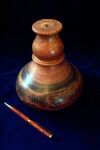
  |
Blackboy Grass-tree Root - Australia
The Grass-tree, or
Black-Boy is an Australian plant. They have shrubby stems with tufts of
long grass-like wiry foliage, from the centre of which arises the tall
flower-stalks which sometimes reach a height of 5 meters and bear dense
cylindrical spikes of blossom at their summit. The shallow root system is
a dense, multi coloured wood like material. This turns easily, but
generates a powder instead of turnings. Takes a high polish if properly
sealed. |

  |
Bodo - Tanzania
A medium sized tree, attaining a height of
20m, and a diameter of 0.4m. Heartwood is a deep red-brown. Sapwood is
off-white and narrow. Straight to slightly interlocked grain, fine even
texture. Dries slowly with a tendency to end split and surface check.
Planing quarter sawn surfaces requires reduced blade angles. Saws
satisfactorily and turns well. Used for construction in East Africa, and,
once dry, for furniture making. |

  |
Bubinga - Cameroon
A large tree, reaches a height of 50m,
diameter is usually in excess of 1m. Heartwood is light red-brown, veined
with pink or red stripes. Sapwood is lighter being usually off-white.
Interlocked grain with fine even texture. Air dries well but sensitive to
direct sunlight when seasoning. Kiln dries well with the very minimum of
degrade. Saws well but tends to tear on quarter sawn surfaces when planing.
Turns reasonably well and takes an excellent finish. A very stable wood
making it a good cabinet making timber. Used for handles and veneers. |

  |
Castello Boxwood - Brazil
A small to medium tree attaining a
height of about 20m and a diameter of 0.1m to 0.3m. The timber is a pale
lemon yellow to almost white colour with little or no distinction between
the heartwood and sapwood. It has a fine even texture with a straight
grain. It is very easy to work and takes a good finish and also a high
polish. Used for musical wind instruments. |

  |
Cherry - United Kingdom
Cherry is easy to work with and has
excellent bending properties. This wood is moderately durable with a
medium crushing strength. The wood is popularly used for making furniture,
decorative turnery, musical instruments, carving and sculpture. Cherry
veneer is widely used for interior cabinets and wall paneling. Cherry has
an attractive figure and is a very popular hardwood due to its unique
color, which varies from a rich red to reddish brown. The wood surface is
smooth with a fine straight grain. Cherry accepts stain well and polishes
to an excellent finish. |

  |
Coolibah Burr - Australia
This is a medium sized woodland
tree and is found widespread on the western plains of New South Wales
extending through the central part of south Australia and part of the
northern territories. The wood itself has an interlocked grain and is very
dense. The colour is purple to red which darkens with exposure. This wood
is capable of taking an excellent finish. Workability is medium to hard. |

  |
Elm - United Kingdom
Ten species of Elm grow in Europe. The
trees are usually large attaining a height of 30 to 40m. The more common
species are English, Dutch and Wych Elm. Heartwood is dull brown, clearly
defined from the lighter coloured sapwood. Irregular growth rings and
cross-grain are more common in English and Dutch Elm. Wych Elm has a green
tinge or stripe and is usually a straighter grained, coarse texture. Used
for furniture, cabinet making, boat building and exterior work. Often,
well burred logs are veneered. |

  |
Goncalo Alves - Brazil
A large tree attaining a height of
45m, with a diameter of 1m to 1.5m. Heartwood is reddish brown often
streaked with dark brown. Straight to interlocked grain, medium texture.
Should be dried slowly to avoid surface checking (tends to warp during
seasoning). Stable once dry, the timber should saw well although planing
can be slightly difficult due to the interlocking grain and should be done
with a reduced cutting angle. Easy to turn. Used for high class furniture
and cabinet making. Well figured logs are often veneered. An excellent
turnery wood. |

  |
Spalted Hornbeam
A medium sized tree with a height of up to
30m, often with a twisted and gnarled bole. Heartwood is dull white, often
with gray streaks, broad rays produce a fleck of quarter sawn surfaces.
Straight to irregular grain, fine even texture. Dries well with little
degrade. Tends to dull saw blades quickly. Machines well, is easy to turn
and takes a very good finish. Used for skittles, flooring and mallets. Has
a high resistance to ear. An excellent wood for turnery. |
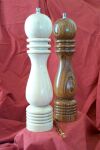
  |
Indian Rosewood
A tall tree of about 38mm in height but has a
short bole often buttressed with a diameter of about .6m. A hard heavy
timber, the heartwood is a dark rusty brown color with a very attractive
appearance. The sapwood is a pale cream color. This wood works well and
takes an excellent polish. Used for turning cabinet making, and musical
instruments. The right hand of the two grinders is Rosewood, the salt
grinder to the left is hornbeam. |

  |
Leadwood - Africa
A small diameter tree, rarely above 0.4m,
attaining a height of 10m to 15m. Heartwood is dark brown with black
lines. Sapwood is creamy white. Straight grain, fine even texture. Dries
slowly with a tendency to check. Sawing is slow, planes well, easy to work
on the lathe, but dusty when working. Finish is excellent. Extremely
dense, sinks in water. Used for furniture, cabinet making, decorative
articles and turnery. |

  |
Larch - United Kingdom
Grown in Central Europe, where it
forms large forests in the Alps, it was first introduced into England in
1639. It grows six times quicker than Oak, which can be seen by the very
open growth rings and open texture. Light Brown to creamy white with
yellow to dark brown lines, the wood darkens with age in a similar manner
to pine. It is employed both in ship and house-building, and in
Cabinet-work is capable of taking a very high polish. Large quantities of
turpentine are collected from full-grown trees. |
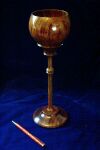
  |
Lignum Bulnesia
Also known as Verawood, it is grown in the
Coastal region of Colombia and Venezuela. Occasionally 30m tall but
usually 12m to 15m with a trunk diameter of 0.3m to 0.5m. Heartwood more
or less striped and banded, varying in colour from light olive green to
chocolate brown. Fine textured, cross-grained, oily appearance and feel.
Used for propeller-shaft bushings, mallet heads and pulley wheels. Turns
easily, as its self lubricating properties make it turn like plastic.
However, those same properties make it almost impossible to shape with
abrasives as the grit clogs immediately |
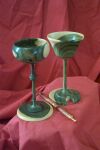
  |
Lignum Vitae
Means "the wood of life". This hard,
dense wood is known for its durability, waxiness and self-lubricating
qualities. Originating in the West Indies and from southern Mexico to
Venezuela. Used for ship propeller shaft and wagon wheel bearings and
bushings. Heartwood is olive brown to nearly black, growing darker upon
prolonged exposure to air. The wood is extremely heavy - the densest
known, with a specific gravity of 1.3 (heavier than water - it does not
float). Difficult to work, but turns well and polishes to a fine,
naturally waxy finish. Does not glue well and rejects most applied
finishes. |

  |
London Plane Lacewood
A medium sized tree reaching a height
of up to 30m and with a diameter of 1.0m. It grows well in cities as a
park land tree. The heartwood is a pale reddish brown. Strong medullary
rays are present showing a distinct figure on quarter sawn faces known as
Lacewood when the timber is cut on the quarter. The sapwood is not
distinct from the heartwood, and it is quick in drying. The timber is easy
to work and polished to an excellent finish, used for furniture, cabinet
making, joinery, and turnery, also veneers on the quarter sawn face |

  |
Brown Mallee - Australia
This wood is found in a relatively
dry area of Australia, from the Eyre Peninsula western New South Wales to
isolated areas of central Queensland. The wood itself is very rare to find
and there is only a small amount of this timber cut each year. The wood is
very close grained and dense, fairly hard to work but with sharp tools
(which are quickly blunted by this material) this can be turned and
polished to a high finish. |

  |
Red Mallee - Australia
This wood is found in a relatively dry
area of Australia, from the Eyre Peninsula western New South Wales to
isolated areas of central Queensland. The wood itself is very rare to find
and there is only a small amount of this timber cut each year. The wood is
very close grained and dense, fairly hard to work but with sharp tools
(which are quickly blunted by this material) this can be turned and
polished to a high finish. The properties of this wood are similar to its
close cousin - brown Mallee, but colouring is more akin to Coolibah. |

  |
Spalted, Figured Myrtle
The hard, strong wood from myrtle is
a favorite for turnery applications such as bowls and specialty items like
candlesticks. Myrtle is readily abundant and often yields a varied, unique
appearance in both lumber and veneer. Myrtle is very popular for high-end
cabinetry and furniture. Due to its hard-wearing characteristics it is
also often used in wall paneling, joinery, boat building, interior finish
and flooring. |

  |
Mopane - Namibia
Varies in size from small bushes up to a 10m
high tree. A very dense, hard wood similar to African Blackwood, machines
well and takes a high finish. Golden orange in colour with chocolate brown
lines. The wood is termite resistant and used as building and fencing
materials and is also used for carvings. The wood is more famous for two
edible species of Mopane worms. They are a treasured delicacy during the
rainy season. |

  |
Oak - United Kingdom
Oaks can develop into huge spreading
trees reaching 40 metres high and producing stems up to 12.5m in girth. In
Britain they can live for over 1,000 years. Strong, durable oak timber was
traditionally used for houses, ships and furniture. Today the best wood is
still used for quality cabinet making, veneers and barrel staves. Oak wood
is golden brown with prominent paler flecks (medullary rays) maturing to
deep brown when used inside, or light silvery grey out of doors |

  |
Ovancol - Ivory Coast
A medium sized tree generally 30m high
and up to 45m, diameter about 0.8m. Heartwood is yellow brown to chocolate
coloured with grey to almost black stripes. Sapwood is pale in colour and
distinct from heartwood, sometimes fairly wide interlocked grain,
moderately coarse texture. Both air and kiln drying is fairly slow, but
degrade is generally low. Saws moderately well but the interlocked grain
can make planing more difficult. Can be brought to an excellent finish.
Used for high class joinery, cabinet work, furniture making and turning. |
| (No image yet) |
Pau Amarello - Amazon
A large tree reaching heights of 40m.
Heartwood is bright clear yellow deepening upon exposure to sunlight, not
sharply defined from the yellowish-white sapwood. Luster is high; texture medium; grain straight to irregular, without distinctive odor or taste.
The wood is reported to be easy to season with little tendency to warp or
check. Used for furniture, parquet flooring, and brush handles |

  |
Steamed Pear - Sweden
Reddish gray heartwood and light
reddish sapwood. When steamed, the wood becomes reddish brown to dark
red-brown. The wood, which is very difficult to split, is hard and
difficult to work, but is easily stained and polished. The timber converts
cleanly but is moderately hard to saw. A clean finish is produced
normally, but a reduction of the cutting angle to 20° is an advantage to
planing. |

  |
Pink Ivory - South Africa
A small to medium sized tree,
rarely exceeding 0.4m diameter, now very rare as the felling of this tree
has been stopped for several years. Heartwood varies from light pink to
dark pink and red with lighter and darker areas of yellow and red. Sapwood
is cream to off-white and wide in comparison to the tree. Straight to
irregular grain, fine even texture. Dries rapidly with little degrade, the
sapwood tends to split. Difficult to saw and machine, dulling blades
quickly, pleasant to work on the lathe. Commercially, one of the rarest
woods in the world. |

  |
Purpleheart - Brazil
The tree varies in height according to locality, can be obtained in height of 38m to 45m, up to 1.2m diameter.
Heartwood is dull brown when freshly cut, changing rapidly to purple on
exposure, gradually toning down to dark brown over a period of time.
Sapwood is cream to off-white. Straight to wavy or interlocked grain,
moderately fine texture. Dries slowly with a tendency to surface check and
end split. Thin sections can be kiln dried successfully. Sawing and
machining is made slightly difficult as it tends to dull cutting edges
quickly. Used for heavy construction, flooring, boat building and turning. |

  |
Ropalla Lacewood - Australia
Found in Queensland, Australia.
A medium sized tree with a height of 15m to 20m and a diameter of 0.5m to
0.8m. Heartwood is deep orange brown with broad, predominant medullary
rays creating a flamed pattern on quarter sawn surfaces and numerous spots
on flat sawn surfaces. Paler brown sapwood, interlocked grain with a
coarse, uneven texture. Moderately slow to dry, prone to end check. Used
for veneers, fancy cabinet work and wood turning. |
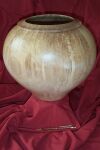
  |
Sycamore - United Kingdom
A large tree up to 35m in height,
with a diameter of up to 1.2m. Heartwood is white to creamy-white, often
with a curly or wavy grain, known as Fiddleback Sycamore. Fine even
texture. Dries rapidly but must be end reared for a short period when
fresh cut to prevent discolouring. Saws and machines well, easy to turn,
capable of a good smooth finish. Used for turnery, furniture, domestic
flooring and musical instruments. Well figured stock is used for violin
backs and veneering. |

  |
American Tulip
White to yellowish cast sapwood; straw-brown
to slightly greenish heartwood sometimes streaked with purple. Basically
straight-grained, light in weight, excellent strength and moderately stiff
and very stable when dried. Very uniform texture, the softness and
evenness of the grain make it excellent for moulding, machining and
gluing. One of the most abundant hardwoods growing in the Eastern U.S., It
grows fast and straight and has excellent woodworking properties. Very
easily sanded and worked. Tasteless, can be used for food packaging. |

  |
English Walnut - United Kingdom
This timber is usually a
greyish brown colour with a dark, straight to wavy grain with a coarse
texture. The timber turns well and always takes a good finish. It is an
excellent timber used for furniture making and turnery. Highly figured
examples are used for high class car interior trims and gun stocks. |

  |
African Walnut - West Africa
A large tree growing up to 30m
in height and a diameter in excess of 1.2m. The heartwood is a bronze
orange brown to light chocolate with gum lines causing black streaks or
lines. The grain is interlocked, sometimes spiral producing a striking
ribbon figure on quartered surfaces. It has a moderately fine texture and
is lustrous. The timber works well with both hand and machine tools, it
glues, stains and polishes to an excellent finish. |

  |
Wenge - West Africa
A medium sized tree up to 15m to 18m in
height, with a diameter of about 1m, mainly found in Zaire. Heartwood is
dark brown with fine, almost black veins, giving an attractive figure on
plain cut surfaces. Sapwood is grey white and narrow, straight to fairly
interlocked grain coarse texture. Should be dried slowly to avoid degrade
such as surface checking. Machines and saws fairly well, turns
satisfactorily and takes a good finish. Used for interior and exterior
joinery and turning. |

  |
Yew - United kingdom
A medium sized tree ranging in height
from 12m to 15m but with a short dole which is never cylindrical because
of its characteristic form. The heartwood colour is golden orange brown
streaked with dark mauve and brown in patches with tiny knots and clusters
in growing bark. The grain is straight but sometimes irregular. A tough
resilient wood, excellent for turning and also used for the making of long
bows. |